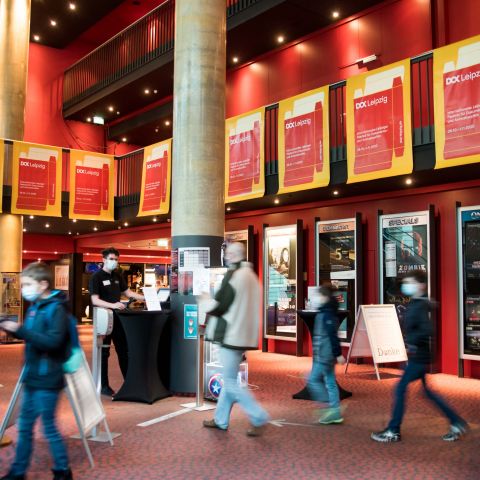
On November 14, the 63rd edition of DOK Leipzig ended with the last of the festival films on demand.
A total of 47.615 visitors took advantage of the hybrid edition of the festival — in person in Leipzig and on the Web. Of these, 5.002 visitors attended cinema screenings. This year’s venues included the festival cinemas, the Grassimuseum and the East Wing of the main railway station. 674 people visited DOK Neuland, the festival’s extended reality exhibition, where they could explore VR installations, 360° films and a sound installation.
The festival’s online offerings included film screenings, discussions with filmmakers and industry offerings such as the DOK Co-Pro Market.
Taking stock, festival director Christoph Terhechte says: “This edition of the festival was a big adventure for us. Organising a festival under these new circumstances meant a huge adjustment for the entire team as well as for all the filmmakers, partners and service providers involved. However, the positive reactions of the visitors and the fantastic level of interest among the public tell us that this huge effort was worth it.”
The online audience, for example, submitted photos of private film screenings via social media, and there was a lot of positive and cordial feedback. “We would like to share this wonderful feedback with the filmmakers, who have lost much of their direct contact with the audience. You deserve special appreciation.”
Despite not being in the same place, the audience and the filmmakers had numerous opportunities to engage in dialogue. One of the challenges facing the hybrid edition was to bring together the cinema audience, the directors at home and the online audience for 12 live film talks. Numerous other live elements also connected the filmmakers and their audiences. “We were very moved by the receptiveness and attentiveness of everyone who took part in the discussions, and we are proud that the connection between online and offline audiences functioned so well,” says festival director Christoph Terhechte. Pre-recorded talks and pre-produced segments rounded out the programme.
Nearly 1,700 accredited professionals took advantage of the festival’s industry offerings at DOK Industry and were networked online across different time zones. The offerings included the DOK Co-Pro Market, the presentations of rough cuts at DOK Preview, the DOK Exchange conference and, for the first time, a series of podcasts on topics relating to the industry.
Looking back, DOK Industry director Brigid O’Shea says: “We thank everyone for their commitment to making this year’s DOK Industry programme a success. Turning up for meetings across time zones, delivering news about the hard production and distribution reality, new partnerships, honouring old commitments. This year was an enormous team effort. I thank all those who made their contributions to a successful week — in particular, the dedication and unending patience of the DOK team.”
This year’s edition of the festival also included the DOK im Knast and DOK Education programmes. For the first time, a training course for teachers on the use of documentary films in the classroom was held in collaboration with Vision Kino. The junior reporters of DOK Spotters were dedicated to covering the festival. Films were also screened in accessible venues this year.
A total of 150 films and XR works were shown during the 63rd edition of DOK Leipzig.
Christoph Terhechte concludes: “The team has seldom faced such a huge challenge, but we all learned an enormous amount in a short time. We will apply the know-how we’ve acquired to future editions of the festival.”